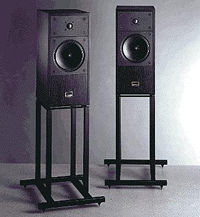| Columns Retired Columns & Blogs |
Epos ES 14 loudspeaker
Americans might be forgiven if they haven't heard of Epos. A small, British specialist loudspeaker manufacturer, it was founded in 1983 by its designer, Robin Marshall—an ex-BBC engineer and a onetime consultant to Monitor Audio, according to Roy Hall of Epos's US importer, Music Hall. Their first model, the ES 20, didn't make it to the US, and was apparently a bit too pricey in the UK to make much of a splash there (about £700, $1300 at the current rate of exchange—a mint in a country with the patent on sub-$500/pair (UK prices!) two-ways). In 1986 or thereabouts, the new, smaller ES 14 was introduced, using updated versions of the same drivers in a smaller, ported cabinet. Music Hall only recently began importing the Epos into the US.
 The drivers in the Epos 14 are custom-manufactured to Robin Marshall's specifications. The bass/mid unit is formed from a polymer said to be highly stable in the face of temperature and humidity variations, and its suspension is designed for linearity in both directions of travel. It incorporates a short voice-coil operating in a long magnetic gap (over three times the length of the coil). The driver is apparently also designed for a minimum required crossover—in fact, there is no crossover in the woofer circuit; it rolls off naturally.
The drivers in the Epos 14 are custom-manufactured to Robin Marshall's specifications. The bass/mid unit is formed from a polymer said to be highly stable in the face of temperature and humidity variations, and its suspension is designed for linearity in both directions of travel. It incorporates a short voice-coil operating in a long magnetic gap (over three times the length of the coil). The driver is apparently also designed for a minimum required crossover—in fact, there is no crossover in the woofer circuit; it rolls off naturally.
There is a high-pass filter in the tweeter circuit, consisting of a single capacitor. That's it. It does even the Monitor Audio's minimal dividing network one better. Thus the Epos 14 is clearly of the "crossoverless is more" school. It goes about as far as possible at the present state of the art in eliminating the crossover—no one has yet come up with a way of eliminating the need for a capacitor, at the very least, to protect the tweeter.
Epos's tweeter is an advanced metal-dome (aluminum) design with an extremely heavy magnet structure and a very high first-breakup mode (well above 20kHz). It is, apparently, less sensitive than the metal-dome tweeter used in the Monitor Audio R852/MD; that system is rated at 89dB/W vs 86dB/W for the Epos. (My own comparative measurements show only a 2dB advantage for the MA, and less than 1dB more than that for the Snell Type Q). The rear of the tweeter dome is vented into a larger-than-normal chamber for reduction of standing waves. A considerable amount of effort, including laser holography, apparently went into the design of this driver.
The Epos's cabinet is solidly constructed, including a steel-rod cross brace. My samples were superbly finished in black-ash wood veneer; they come without grilles (a removable grille is apparently in the works to satisfy customer demand) and had a very attractive yet businesslike high-tech look—very much in the Celestion SL700 mold, though with wood cabinets. The system is reflex-loaded (in contrast to the sealed enclosures of the Snell Q and Monitor Audio designs), with the port located in the rear, as is a single pair of banana jacks.
My only functional criticism of the Epos is of these jacks; they are of high quality, but five-way binding posts would be welcomed by most users. And the speakers also deserve a bi-wire option. Coincidentally, the 14s were almost precisely the correct width to cosmetically match the 24" Chicago Speaker Stands used in the auditioning—which placed the bass/mid at about ear level and the tweeter just above. Epos's own stands were not available for the review, but I have a feeler out to Santa Fe to locate them and will report in a future update if one is warranted.
- Log in or register to post comments




































